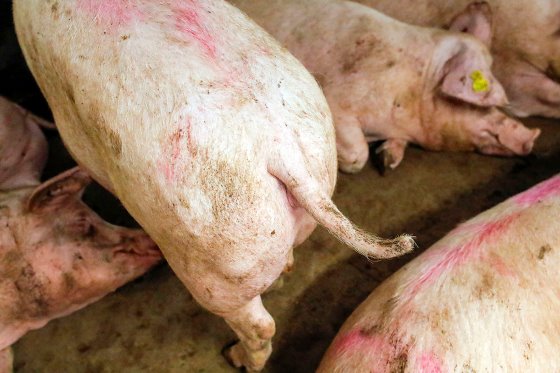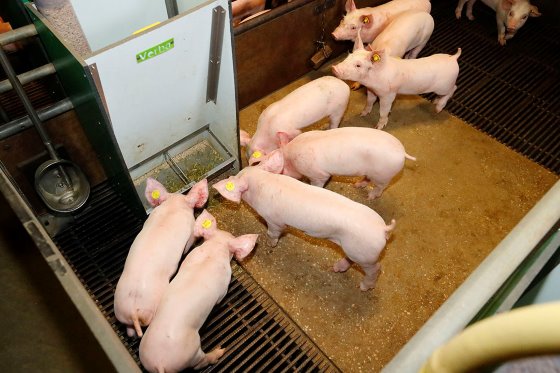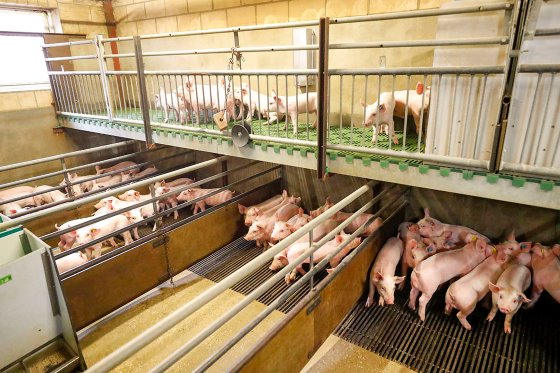Farrow-to-finish farm Jansberg in the south of the Netherlands is a good example of swine farming with a modern outlook. The farm appears permanently in transition, applying modern technology and looking ahead, and is open to novel ways of making money. Recently a new gestating sow area was constructed, and the aim is to use as few antibiotics as possible.
Visiting Jansberg farm feels a little bit like doing athletics. It’s great to admire the new spacious gestating sow area, but – erm – watch your step as the occupants don’t really give way. So today’s visit is more like an obstacle course with visitors carefully hopping over snoozing bodies, each weighing 200+ kg, while hoping one of them will not suddenly rise.
Owner Tom Janssen, age 33, had this extension to the farm built in 2018. He felt it was time for a modern gestating area at his facility near Castenray, Limburg, the Netherlands. Although he has worked at the site since 2008, only in 2017 did he fully become an owner of the location, which is when he embarked on constructing a large gestation room. “I wanted it to be one big area,” he explains. “I like it when I can see far away.”

Bird's eye view of the Jansberg gestating sow area. - Photos: Bert Jansen
Wide and tall
The result is one massive room of 40m x 25m, with space for 220 gestating sows at different stages of pregnancy. Not only is it wide, it is also tall, as the roof is 7m above the ground. The new building offers climatic advantages, Janssen explains. “In the winter we never have to do any additional heating. You can imagine that there is a lot of heat coming from the animals themselves.” In the Netherlands, temperatures may drop to -10˚C but in recent years this has only very rarely happened. He continues, “In summer, this system is great as we can ventilate as much as possible. Warm air going round is not a draught. We hardly have any problem with bad smells.”

The gestating sows have fresh straw at their disposal.
Breeding area
The large area also includes a semi-open compartment for insemination purposes. There are two rows of 35 crates, supplied with additional TL lighting, which provide light from 6am until 10pm. Initially, strangely enough, Janssen achieved a breeding rate of only 90%, with 10% being not-in-pig. He solved that by having the sows go round in the area the first two days after weaning. Once they had had their bit of movement, the breeding rate went up to be virtually perfect. Sows are moved into the general gestation area after four to five days, which is in line with legislation in the Netherlands.

The gestating sows' tails are only partially cut.
Looking ahead and investing
With his investment of a new gestating sow facility, Janssen has shown clear optimism about the future of his farm in an otherwise fairly complex market. Yes, current prices mean it is good to be a pig producer in Western Europe these days due to African Swine Fever in other parts of the world. Nevertheless, in the densely populated Netherlands, pig production is increasingly under pressure. In recent national surveys, nitrogen deposition values have been found to be too high and, increasingly, the authorities appear to identify the livestock industry as the number one business to blame for that. In an attempt to reduce the effect of livestock production on the environment, a nationwide scheme allows producers to sign up if they are ready to shut their business. It is characteristic of the climate in the Dutch pig industry that over 500 farmers have chosen to sign up.
Farrowing area
Not Tom Janssen, though. Besides the gestating sow house, the piglet area was reconstructed in 2019 and his next plan involves a reconstruction of the current lactation house. Currently it houses 120 sows, and as the buildings are rather outdated, they will be demolished in the course of 2020. The first step in this process is to replace the current capacity – a capacity upgrade is possible but not yet planned. Janssen says, “These buildings will also be one open space; again, that’s what I prefer. We also took into account that in the future it might become law that sows will have to be loose during most of lactation. I’m pretty sure it will head that way – perhaps not in the next 10 years, but it will come. If that turns out to be true, we can easily convert to those new requirements.” Currently he weans 30 piglets/sow/year – due to more space being available for the piglets in the new farrowing and lactation house as from late 2020, Janssen expects that figure to go up.

At Jansberg farm, technical results of weaning piglets can be followed.
Upbeat about the future
One way of going that extra mile is that for several years, his farm has also been a trial farm for Joosten Young Animal Products, including products developed to reduce antibiotics usage (see also box). The company mostly produces high quality feed for piglets. The products obviously need to be tested and tried often under commercial conditions so there will be plenty of documented experience about their efficacy before they hit the market.
The testing in the weaner buildings, which were renewed in 2019, involves various rounds of weighing. Janssen says, “It is usually quite a lot of extra work, as we would normally do that roughly five times per production round. Typically I will place most piglets apart and then weigh them one by one. What is helpful is that each piglet has a radio-frequency identification (RFID) tag in their ear, so data can easily be stored.”
These tests are usually blind, he says, that is he does not know which batches get the feed with Joosten products included and which get the control feed. Positive or negative results for him are impossible to gauge, he says. “That is usually a matter of 50g or so, which is impossible to see with the naked eye. The only thing that one sometimes can see is faeces quality. When the feed is highly digestible, you’ll see that there is not a lot of diarrhoea occurring.”

A clever way of adding extra space in the farm: a pen on a second floor.
Antibiotics usage
The RFID also plays a role in another future-proof project: Jansberg is participating in the Westfort slaughterhouse’s scheme to market antibiotic-free meat. As such, the farm is trying to get by without the usage of antibiotics. Seeing that the farm produces its own breeding stock, the disease pressure is relatively low. Antibiotics are only used on an individual basis, Janssen says. “We may treat an individual pig for a cough or a sow for lameness. Then we will fill that out in the system that corresponds to the animal’s ear tag, so at the slaughterhouse they will know which ones to process differently.”
Manure treatment
Last but not least, outside the farm there is a huge manure separation truck installed, pumping up the manure from the pits and separating it into liquid and solid parts. Janssen says, “The liquid part is being spread out on the land nearby, but the solid part is sold off.” He grins: “It’s the black gold.”